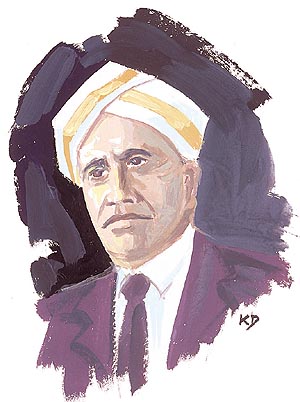WHEN Sir C. V. Raman was in Stockholm to receive his Nobel Prize, they raised a toast and invited him to have a drink. The vegetarian and teetotaller scientist politely refused, upon which one of the hosts remarked, 'You delighted us this morning with a demonstration of the Raman Effect on alcohol; why not continue the celebration by showing us the effect of alcohol on Raman?'
 This prodigious genius was only twelve when he finished his school education. When in 1901 he walked in as student of the Presidency College, Madras, to attend his B. A. class, other boys made fun of him. Even his teacher, Professor E. H. Elliot, thought that a little schoolboy had walked in by mistake. Soon he excelled in the college, and he was scheduled to go to England for higher studies, but owing to his frail physique he was not thought fit to travel. Raman did not lose heart, and made a firm resolve to make his researches in India itself.
This prodigious genius was only twelve when he finished his school education. When in 1901 he walked in as student of the Presidency College, Madras, to attend his B. A. class, other boys made fun of him. Even his teacher, Professor E. H. Elliot, thought that a little schoolboy had walked in by mistake. Soon he excelled in the college, and he was scheduled to go to England for higher studies, but owing to his frail physique he was not thought fit to travel. Raman did not lose heart, and made a firm resolve to make his researches in India itself.
Impressed by his brilliance, Sir Ashutosh Mookherjee offered him the post of Palit Professor of Physics at the Calcutta University in 1917. He was elected Fellow of the Royal Society in 1924, followed by a knighthood in 1929. He became the first Indian scientist to win the coveted Nobel Prize (1930) for 'Raman Effect' a discovery that showed that a change occurs in the frequency of light when passed through a transparent medium. The effect is important in the study of molecular structures. Raman also made significant contributions to the study of synthetic diamonds, a study that led to better understanding of X- Rays. He made a special study of acoustics, especially the working of the tamboora. He moved to Bangalore in 1933 to become Director of the Indian Institute of Science, and ten years later founded the Raman Research Institute there. He was honoured with a Bharat Ratna in 1954.
No comments:
Post a Comment